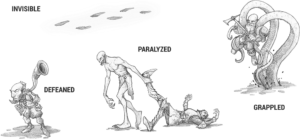Even MORE Commonly Confused Rules in D&D 5e

The more I dug into the lesser known or often misinterpreted rules of Dungeons & Dragons, the more material I found to discuss. One article has grown into three. You can view the first two articles here and here.
So, without further ado, let’s discuss five more commonly confused rules for Dungeons & Dragons 5th edition.
Help Action
 Dungeons & Dragons wouldn’t be the game we all love if it was merely a solo adventure. A large component of tabletop roleplaying games is the camaraderie between players. The Help action provides a specific rule mechanic for players to help each other during a combat scenario.
Dungeons & Dragons wouldn’t be the game we all love if it was merely a solo adventure. A large component of tabletop roleplaying games is the camaraderie between players. The Help action provides a specific rule mechanic for players to help each other during a combat scenario.
With the Help action, you can aid another creature in the completion of a task (PHB p. 192). You grant advantage to an ally’s skill check or attack roll.
The skill check component is straightforward. You declare what task you are helping with and if the other creature performs that ability check before the start of your next turn, they have advantage on their roll. From a narrative standpoint, it could be throwing your body weight against a door to help the other character keep it closed or working together to rifle through a desk’s drawers to find an incriminating document.
There are a few restrictions for aiding an attack roll. The target of the attack must be within 5 feet of the creature that is using the Help action. The rule doesn’t specify that the attacking creature must be within that 5-foot range, just that the helping creature is. It’s like you are feinting, yelling, dodging around, and otherwise distracting the target so that your ally can get past their defenses.
A fantastic strategy is to have familiars or other summoned creatures use the Help action. Often, either those creatures are not able to take the Attack action or a character must sacrifice their own action to allow it. But familiars summoned by the find familiar spell can take any other actions as normal (PHB p. 240). There is a risk to the familiar because it must be within 5 feet of the target of the attack, but sometimes gaining advantage on a specific attack roll can be worth it. It’s also worth noting that a familiar can help creatures other than their summoner. A wizard could instruct their familiar to use the Help action for any other ally.
Conditions
 A condition is a status effect upon a creature that alters that creature’s capabilities in some way (PHB p. 290). Most of them are impairments, but a few can be advantageous. They last until they are countered or for the duration specified by the effect that imposed the condition. Creatures can have multiple conditions at the same time, and all must be resolved individually. If a creature has the same condition imposed upon them by two or more means, the effect of the condition doesn’t get worse, but each cause must still be resolved separately (PHB p. 290). For example, if a creature is Blinded by the blindness/deafness spell and within an area of magical darkness that causes Blindness, then they must leave the magical darkness and succeed on their saving throw against the spell in order to no longer be Blinded.
A condition is a status effect upon a creature that alters that creature’s capabilities in some way (PHB p. 290). Most of them are impairments, but a few can be advantageous. They last until they are countered or for the duration specified by the effect that imposed the condition. Creatures can have multiple conditions at the same time, and all must be resolved individually. If a creature has the same condition imposed upon them by two or more means, the effect of the condition doesn’t get worse, but each cause must still be resolved separately (PHB p. 290). For example, if a creature is Blinded by the blindness/deafness spell and within an area of magical darkness that causes Blindness, then they must leave the magical darkness and succeed on their saving throw against the spell in order to no longer be Blinded.
There are officially fourteen conditions and one special condition in D&D 5e. In my opinion, “surprise” could be considered another special condition. The wording and rules for it are similar enough that I think about it in terms of a condition. I discussed how “surprise” works in the previous articles.
You can find all the conditions on pages 290-292 of the Player’s Handbook. Most of them can be guessed based on the name alone (e.g., a Deafened creature can’t hear and so automatically fails ability checks that require hearing). For this discussion, I’ll focus on the aspects of each condition that are sometimes overlooked or misinterpreted.
- Blinded: A Blinded creature follows the rules of Unseen Attackers and Targets (PHB p. 194-195). Remember that a Blinded creature cannot take an Opportunity Attack because those can only be done against creatures “you can see” (PHB p. 195).
- Charmed: Players sometimes treat the Charmed condition like a mind control effect, expecting a Charmed NPC to do whatever they want. But it just prevents the Charmed creature from targeting the charmer with anything harmful while also giving the charmer advantage to social checks. This means a Charmed creature could still attack allies and would have to be persuaded to do something it normally wouldn’t do.
- Deafened: Some argue that a creature that is Deafened should not be affected by the thunder damage type. However, thunder damage does not include that exclusion since it is a “concussive burst of sound” (PHB p. 196). A person who is deaf is still able to feel the vibrations caused by sound waves. Thunder damage is just a sound wave that is powerful enough to deal physical damage.
- Frightened: A frightened creature has disadvantage to all ability checks and attack rolls, not just ones made against the cause of the fear. If they lose line of sight to the source of their fear, they no longer have that disadvantage. They are still considered Frightened, however, until the effect is ends in some way. That means they cannot willingly move toward the source of their fear. As soon as they are within line of sight again, the disadvantage continues.
- Grappled: Players often confuse the Grappled condition with the Paralyzed or Restrained conditions. But all the Grappled condition does is reduce a creature’s speed to 0. There is no advantage or disadvantage with it, and, although they can’t move, they can still perform any other action, such as attack or cast a spell. If they want to escape the grapple, they must succeed on a Strength (Athletics) or Dexterity (Acrobatics) check contested by a grappler’s Strength (Athletics) check (PHB p. 195).
- Incapacitated: This one is self-explanatory, but it is worth noting that being incapacitated doesn’t mean a creature is unaware of its surroundings. That is reserved for the Unconscious condition.
- Invisible: Just because a creature can’t be visibly seen doesn’t mean they can’t be noticed in some other way. They follow the rules of Unseen Attackers and Targets. One big benefit of invisibility is that an invisible creature will never trigger an Opportunity Attack.
- Paralyzed: The creature can’t do anything, attack rolls have advantage, and any melee attacks within 5 feet is considered a critical hit. Ouch. Note that it is not all melee attacks – it specifies that it must be within 5 feet, so a polearm or other weapon with reach would not apply unless they were within 5 feet.
- Petrified: The even worse sibling to the Paralyzed condition. Instead of melee attacks being critical hits, a creature becomes resistant to all damage – since they are now an inanimate object.
- Poisoned: This is often confused with the poison damage type. Poison damage does not cause the Poisoned condition unless it is explicitly stated.
- Prone: The disadvantage on attack rolls by a prone creature and the advantage on attack rolls against it is logical. A prone creature must use half its total speed to stand (PHB p. 191). A prone creature can always choose to crawl (which functions like moving through difficult terrain). Remember, that all ranged attacks against a Prone creature are at disadvantage.
- Restrained: This has aspects of both the Grappled and Paralyzed conditions. The creature’s speed becomes 0, but they are not incapacitated – so they may still take actions like with the Grappled condition. Unlike the Paralyzed condition, a creature doesn’t automatically fail Strength and Dexterity saving throws, they just have disadvantage on Dexterity saving throws. Also, no automatic critical hits.
- Stunned: This is the Paralyzed condition without the automatic critical hits.
- Unconscious: This is probably the most common condition an adventurer faces. They are incapacitated, unaware of their surroundings, drop what they are holding, and fall prone. Attacks against it have advantage, so, although the Prone condition applies, ranged attacks against it would be a straight roll. Since it specifically states that creatures automatically fail their Strength and Dexterity saving throws, that means creatures are still able to make saving throws using other ability scores, such as Wisdom.
- And the Special Condition – Exhaustion: This is a multi-leveled, compounding effect. Finishing a long rest only reduces a creature’s level of exhaustion by one level, and they must have ingested some food and drink that day.
My advice to players and DMs is to be very familiar with the Prone and Unconscious conditions as those are the most common. Before a game, DMs should review any conditions that a planned encounter could cause, and players should take responsibility to learn the conditions they can cause with their spells and class features.
Ritual Casting
 Most spells can be cast swiftly using an action, bonus action, or reaction, but casting them in such a manner takes a toll on the spellcaster – or, to put it mechanically, they require spell slots. However, there are some spells that can be cast over a longer period without using a spell slot. These spells are specifically noted as ritual spells. If a spell does not have the “ritual” tag, then it can’t be cast as a ritual spell (unless a class feature or some other ability says otherwise).
Most spells can be cast swiftly using an action, bonus action, or reaction, but casting them in such a manner takes a toll on the spellcaster – or, to put it mechanically, they require spell slots. However, there are some spells that can be cast over a longer period without using a spell slot. These spells are specifically noted as ritual spells. If a spell does not have the “ritual” tag, then it can’t be cast as a ritual spell (unless a class feature or some other ability says otherwise).
Not all spellcasters can cast spells as rituals. The ability to do so will be listed in the class’s features. For example, all clerics have the ability, but sorcerers do not. There is a feat called Ritual Caster (PHB p. 169) that grants the ability, and the character doesn’t even have to be a spellcaster, which is neat.
Casting a spell as a ritual takes 10 minutes longer than it would normally take to cast the spell. So, ritual casting is not something that can practically be done during combat. This means that a ritual spell will always be at least 10 minutes and six seconds (for a standard casting time of 1 action), but some may be even longer. For example, the augury spell has a casting time of 1 minute. Casting it as a ritual would take 11 minutes. It also requires concentration for the entire casting time, so you cannot engage in conversation or perform any other actions while casting a ritual spell.
Cover
 A great way to add a dynamic element to combat scenarios is to provide areas of cover, such as trees, walls, or large objects. The rules are straight forward, but often confused with the rules from earlier editions, or just forgotten in the middle of combat.
A great way to add a dynamic element to combat scenarios is to provide areas of cover, such as trees, walls, or large objects. The rules are straight forward, but often confused with the rules from earlier editions, or just forgotten in the middle of combat.
A target can, of course, only benefit from cover when the attack or effect originates from the opposite side of the cover. It’s divided into three tiers, and a target can only benefit from one cover bonus at a time. For example, a target with half cover from a tree, but three-quarters cover from a boulder would only gain the benefit of three-quarters cover. The two different degrees of cover would not stack (PHB pg. 196).
The smallest amount of cover is half cover. It provides a +2 bonus to AC and Dexterity saving throws. As the name states, the creature must have at least half of its body blocked by an obstacle. Creatures, whether allies or foes, can be considered an obstacle if they are the same size or larger and block the attacker’s line of sight.
Next is three-quarters cover. This provides a +5 bonus to AC and Dexterity saving throws. Some examples included in the Player’s Handbook are a portcullis, arrow slit, or a thick tree trunk.
Finally, there is total cover when a creature is completely concealed by the obstacle. It is not the same as being hidden. A DM could rule that it allows you to make a Dexterity (Stealth) check, and may even grant advantage for the check, but it is not required that they do so. A creature behind total cover can’t be targeted directly by an attack or a spell but can still be reached by an area of effect. Interestingly, there is no mention of a bonus to Dexterity saving throws while behind total cover. This is likely because being behind total cover means the attacker is also concealed; a creature wouldn’t be able to see the attacker for that split second of warning before an effect occurred.
Multiclassing Prerequisites
 Sometimes due to how a character’s story progresses, a player decides they want to take levels in a class that is different from their starting class. I’m not going to discuss the entire process for multiclassing (found on p. 163-164 PHB). But I did want to mention that characters can only multiclass if they meet the ability score prerequisites.
Sometimes due to how a character’s story progresses, a player decides they want to take levels in a class that is different from their starting class. I’m not going to discuss the entire process for multiclassing (found on p. 163-164 PHB). But I did want to mention that characters can only multiclass if they meet the ability score prerequisites.
The ability score prerequisites are different for each class. A character must have their current class ability score minimum as well as the new class’s minimum to be eligible to multiclass. For example, a fighter who wants to pick up a monk level must first have the fighter ability score minimum of a 13 in Dexterity or Strength. Then, in order to take a level in the monk class, they must have a Dexterity of 13 and a Wisdom of 13.
The rationale for these limitations is that a multiclass character lacks the typical training for the new class so they must have a natural aptitude for the skills.
Conclusion
As I said in my first article on this topic, the rules are as important to a game as a skeleton is to a body. Knowing the rules well allows you to build off that framework and make a game your own. I hope that after these three articles, you have the confidence to take your games to the next level!
Have I covered all the rules you expected? If not, let me know in the comments. I’d also love to know what other D&D or roleplaying related topics, especially for new players and DMs, that you’d like me to discuss in the future.



